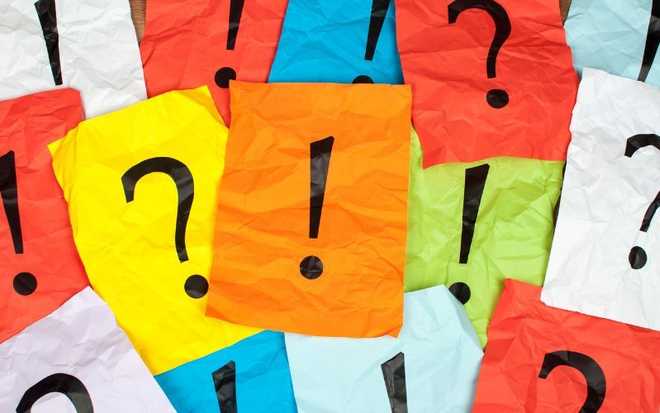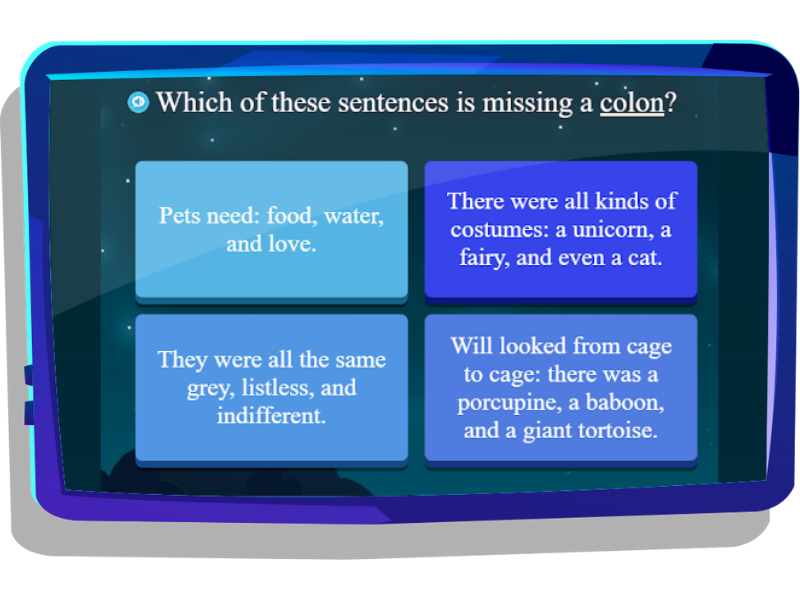Grade 5 Punctuation
Discover Grade 5 punctuation standards

Home > Language Arts > Punctuation > Grade 5
In fifth grade, the complexity of the punctuation your child is expected to use increases, however many children still benefit from reviewing previous learnings acquired between first grade and fourth grade. You can go through earlier elementary content with your child, by visiting the pages linked above!
This guide will talk you through some key concepts and examples of punctuation use that they’ll be expected to know by the end of Grade 5. Let’s get started!
Commas and Semicolons in a Series
A series is a list of three or more items.
If those items are single words, then we can separate them using a comma.
After each item in the list, we include a comma:
- Sam the Spying Giraffe likes to eat bananas, apples, pizza, and ice cream.
If the items in the list contain commas, then we separate the items with a semicolon. Often, you will use a colon (:) to introduce this type of list.
Example
There are lots of talented animals in The Pink Punk Birds band: Florence the flamingo, vocals; Fingle the fox, flute; Viola the vole, violin; and Chan the cheetah, cello.
- Each item in the list includes the animal’s name, species, and role in the band
- A semicolon separates each item in the list
- A comma separates the animal and their instrument within each item
Practice Tip
You could challenge your child to take a quiz involving missing colons or incorrectly placed colons. You could create some questions very simply on paper, or you could use the quizzes available on Night Zookeeper just like the one pictured below.

Commas in Sentences
Sentences are made up of clauses, which are different parts of a sentence. A main clause is a complete thought, which makes sense on its own. Another name for a main clause is an independent clause.
Sometimes we add an introductory element to the beginning of a sentence before the main clause. The introductory element can be a dependent clause (a clause which doesn’t make sense on its own) or an adverb.
The introductory element begins the sentence. Always follow an introductory element with a comma. The independent clause makes sense on its own as a complete thought.
Dependent Clause Example
When he got home, Will grabbed a drink and went up to his room.
Adverb Example
Earlier, Riya made a beautiful collage for Florence.
Commas in Dialogue
When we respond to a question, we need to use commas to help make our response clear. If you respond to a question with yes or no, always separate these responses from the rest of your sentence with a comma.
Example 1
“Did you have a good time?” asked Will.
“Yes, I had a great time!” said Riya.
Example 2
“Do you think the Night Zookeeper will let the Voids into Igloo City?” asked Eek.
“No, never!” said the Professor emphatically.
Similarly, when you address somebody, use a comma to separate their name from the rest of the sentence:
“Hi, Will,” said a girl’s voice.
Titles of Works
When you refer to a book title or the title of a piece of work in your writing, you need to punctuate it correctly. There are three different ways to do this! Just make sure you are consistent throughout your writing with the style you choose.
Underlining
- In The Giraffes of Whispering Wood, Will accidentally creates a mysterious portal during a trip to the zoo.
‘Quotation Marks’:
- In ‘The Giraffes of Whispering Wood’, Will accidentally creates a mysterious portal during a trip to the zoo.
Italics:
- In The Giraffes of Whispering Wood, Will accidentally creates a mysterious portal during a trip to the zoo.
How Night Zookeeper can help

Night Zookeeper can help your fifth grader level up their punctuation skills in a matter of weeks!
Our award-winning language arts program covers all the punctuation rules young learners should understand at this grade level, featuring word games, punctuation lessons, exciting challenges, and much more.
Our program keeps children engaged and motivated to learn, and we even send out monthly worksheets and printable resources for learning on-the-go.
Sign up today to get a FREE 7-day trial!
Related articles


Make Reading & Writing Fantastically Fun!
- Award-winning reading & writing program for kids
- Improves spelling, grammar, punctuation & vocabulary
- Over 1,000 different learning games and activities



